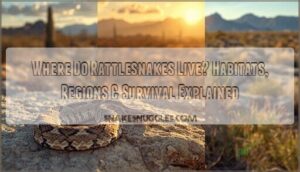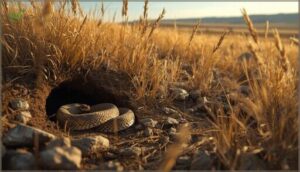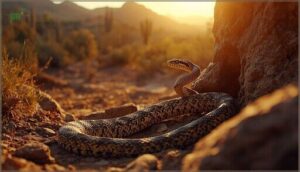This site is supported by our readers. We may earn a commission, at no cost to you, if you purchase through links.
 You’ll find rattlesnakes across an impressive span of the Americas—from southern Canada’s grasslands down to central Argentina’s scrublands. These venomous pit vipers have conquered an astonishing variety of landscapes, thriving in sun-baked deserts, pine forests, coastal wetlands, and mountain slopes. Arizona alone hosts 14 different rattlesnake species, while West Texas harbors some of the continent’s densest populations.
You’ll find rattlesnakes across an impressive span of the Americas—from southern Canada’s grasslands down to central Argentina’s scrublands. These venomous pit vipers have conquered an astonishing variety of landscapes, thriving in sun-baked deserts, pine forests, coastal wetlands, and mountain slopes. Arizona alone hosts 14 different rattlesnake species, while West Texas harbors some of the continent’s densest populations.
Understanding where these reptiles live isn’t just about avoiding an unpleasant encounter. Their distribution patterns reveal how they’ve adapted to extreme temperatures, scarce water, and fragmented habitats—adaptations that are now being tested as development pushes into their territories and climate shifts alter the environments they’ve occupied for millions of years.
Table Of Contents
- Key Takeaways
- Where Do Rattlesnakes Live?
- Geographic Distribution of Rattlesnakes
- Types of Habitats Rattlesnakes Occupy
- How Rattlesnakes Survive in Their Environments
- Rattlesnake Behavior and Habitat Use
- Conservation and Threats to Rattlesnake Habitats
- Frequently Asked Questions (FAQs)
- Where do rattlesnakes live in the winter?
- Where do rattlesnakes live?
- Where do rattlesnakes live in South America?
- Where do ratsnakes live?
- Why do rattlesnakes live in different habitats?
- What are the most common Rattlesnakes in North America?
- How Can I Protect Rattlesnakes From Persecution?
- What Do Rattlesnakes Typically Eat?
- How Long Can Rattlesnakes Live?
- What is the Most Toxic Rattlesnake Venom?
- Conclusion
Key Takeaways
- Rattlesnakes span from southern Canada to central Argentina, with Arizona hosting 13 species and the southwestern United States and Mexico showing the highest species diversity across habitats ranging from deserts to wetlands.
- These pit vipers survive through ectothermic adaptations like heat-sensing organs and behavioral thermoregulation, often returning to the same communal dens annually where up to thirty individuals may gather during brumation.
- Habitat loss and fragmentation from urbanization and agricultural expansion threaten rattlesnake populations, with conservation status varying dramatically by region—a species endangered in one state may be unprotected in another.
- Rattlesnakes play a crucial ecological role by controlling rodent populations through ambush hunting, with their diet shifting from lizards in juveniles to mammals like rats and ground squirrels in adults.
Where Do Rattlesnakes Live?
Rattlesnakes cover a surprising stretch of ground across the Americas, finding homes in all sorts of places. You’ll see them thriving in regions you mightn’t expect.
Let’s take a closer look at where these snakes actually live.
Native Range in The Americas
Across the Americas, rattlesnakes stretch from southern Canada to central Argentina, thriving in habitats as varied as deserts, forests, and grasslands. You’ll find the greatest species richness in the southwestern United States and Mexico. Their range expansion is shaped by climate and habitat preferences, with population data revealing isolated groups and conservation concerns in fragmented habitats. Rattlesnakes are known to use heat-sensing organs to detect prey while hunting.
- Southern Canada
- United States
- Mexico
- Central Argentina
Key Regions With High Populations
You’ll notice rattlesnake populations peak in regions where habitat and range overlap with ideal conditions. Arizona stands out for species diversity, while West Texas shows considerable density. The southeastern coastal plain features large eastern diamondback populations. Mexico’s Sonora and Veracruz are true hotspots for survival and species distribution. Rattlesnakes are widespread, but some states have no rattlesnakes at all.
Here’s a quick look at key rattlesnake habitats:
| Region | Notable Feature |
|---|---|
| Arizona | Species diversity |
| Texas | High density |
| Coastal Plain | Eastern diamondback |
| Sonora/Veracruz | Hotspot survival |
Range Limits and Outliers
While high-density regions get most of the spotlight, rattlesnake habitat and range stretch to surprising edges. At these limits, you’ll see Northern survival tested by cold and habitat fragmentation, and Southern diversity thriving. Outlier genetics set populations apart, making range monitoring key for rattlesnake species distribution. Here’s what sets outlier snake habitats apart:
- Isolated den complexes
- Reduced gene flow
- Unique microhabitats
- Slow population turnover
- Distinct genetic clusters
Geographic Distribution of Rattlesnakes
Rattlesnakes aren’t limited to just one corner of the map—they’re spread across a wide range of regions. You’ll notice they show up in some places more than others.
Let’s look at where these snakes are most commonly found.
United States Distribution by Region
Ever wondered why rattlesnake habitat and range shift so dramatically from state to state? In the United States, regional species diversity is striking—Arizona leads with 14 types, while Florida has just three.
Habitat variations, population threats, and bite incidents differ by region. Conservation efforts target specific rattlesnake species distribution, adapting to unique rattlesnake habitats and behavior across the country.
Rattlesnakes in Mexico, Central, and South America
Step into Mexico, and you’ll find unparalleled rattlesnake diversity—at least 43 native species weaving through every state, from pine-oak forests to arid grasslands.
Central America’s main rattlesnake, Crotalus simus, thrives in dry forests. South American rattlesnakes, like Crotalus durissus, favor savannas and grasslands.
Conservation status and regional threats shape snake habitat and species survival across these regions.
States and Areas With Highest Species Diversity
Arizona’s diversity stands out, with fourteen rattlesnake species thriving in habitats from deserts to mountain canyons. California follows closely, hosting twelve types across varied terrain. Texas adds nine more, while Southwestern hotspots like New Mexico and Utah support several unique snake species.
This species concentration means rattlesnakes weave their way through these states’ landscapes, adapting to each distinct habitat.
Types of Habitats Rattlesnakes Occupy
Rattlesnakes are experts at making themselves at home in all kinds of places. You’ll find them thriving in some environments you mightn’t expect.
Here’s a look at the main habitats where these snakes prefer to settle.
Deserts and Arid Regions
Picture the desert at dusk—it’s prime territory for rattlesnakes. Desert species like Crotalus thrive in rocky canyons and sandy flats, relying on arid adaptations to survive harsh conditions.
Regional densities peak in places like California, where seasonal responses keep them hidden during extremes. Conservation threats loom as rattlesnake habitat and range shrink, especially in the American Southwest.
Grasslands and Prairies
What makes grasslands and prairies so important for rattlesnakes? In these open spaces, prairie populations depend on burrow usage for survival and camouflage coloration for hunting rodents.
Habitat fragmentation threatens their movement and den sites, while climate impacts may shift their range.
Conservation needs are urgent—protecting these prairies means safeguarding rattlesnake communities and the balance they bring to these ecosystems.
Forests and Woodlands
Did you know timber rattlesnakes thrive beneath the forest canopy, weaving through rugged terrain and rocky ledges in regional forests? Edge habitats and sunlit clearings offer important basking spots, while denning sites hide deep in crevices.
Habitat fragmentation threatens these ecosystems, shrinking rattlesnake habitat and range, and impacting wildlife balance. Protecting snake habitat and range keeps forests healthy.
Swamps, Wetlands, and Near Water
Ever wondered how rattlesnakes handle soggy ground and rising water? Wetland adaptations let species like the eastern massasauga thrive in bogs, marshes, and floodplains, using vegetated hummocks for shelter.
Swamp survival means finding water proximity and microhabitats, even brumating in saturated soils.
Conservation status is critical—habitat loss in wetlands and swamps shrinks snake habitat and range, impacting entire ecosystems.
How Rattlesnakes Survive in Their Environments
Rattlesnakes have developed smart ways to handle the challenges of their surroundings. Their survival depends on several key strategies that help them stay safe and active year-round.
Here’s how they make the most of their habitats.
Ectothermic Adaptations
Across deserts and forests, rattlesnakes rely on sharp ectothermic adaptations to survive. These coldblooded hunters use heatsensing organs and precise thermoregulation accuracy to keep their body heat within a safe temperature range. You’ll notice their clever strategies:
- Basking for warmth
- Metabolic suppression during cold
- Active behavioral adaptations
- Shifting activity with climate responses
- Choosing microhabitats for best heat
Shelter and Denning Sites
When the temperature drops, rattlesnakes rely on shelter selection to find dens with the right microhabitat. You’ll see strong site fidelity—many return to the same wintering areas, especially on the Allegheny Plateau.
Communal denning isn’t rare; some dens host up to thirty snakes. Social behaviors shift near dens, helping them face challenges for snake survival during colder months.
Seasonal Behavior and Brumation
Once rattlesnakes settle into their wintering dens—often on the Allegheny Plateau—Brumation Ecology takes over. Snake behavior slows, metabolic adaptations kick in, and movement drops to a minimum. They stick close to familiar dens, showing strong den fidelity.
Most activity happens when temperature ranges climb above freezing, with occasional surface movement for hydration or basking before spring’s seasonal movement begins.
Rattlesnake Behavior and Habitat Use
Rattlesnakes use their surroundings in some interesting ways, shaped by both instinct and environment. How they hunt, defend themselves, and raise their young depends on where they live.
Here’s a closer look at the places they choose for each part of their lives.
Hunting and Feeding Grounds
How do these quiet hunters shape their world? Your local rattlesnake uses sharp sensory perception and patient ambush tactics to target prey. Their diet leans heavily toward rodents, but habitat variability means you’ll find them foraging in fields, woodlands, and rocky edges. Their consumption rates help control rodent populations, weaving an essential ecological role into every hunting ground.
- Diverse prey preferences across regions
- Foraging strategies: ambush and migration
- Habitat variability influences hunting success
- High consumption rates stabilize ecosystems
Defense Mechanisms in Various Habitats
In open grasslands, rattling frequency spikes—rattlesnakes rely on their iconic warning signals to deter potential aggressors.
Woodland and desert habitats favor crypsis effectiveness, with snakes blending in and rarely needing a defensive pose. Hissing costs rise in arid zones, limiting its use, while venom expenditure is reserved for last-resort defense.
Habitat variability shapes every aspect of rattlesnake behavior and defense.
Mating, Nesting, and Life Cycle Locations
During summer rains, you’ll find snake species gathering in Mating Microhabitats—rocky outcrops, grassy knolls, or ledges.
Females choose Communal Rookeries for birthing, supporting the ovoviviparous Rattlesnake life cycle.
Neonate Dispersal follows, with young traveling to dens. Environmental Influence shapes timing, and a female’s Reproductive Lifespan often includes site fidelity, important for sustaining Rattlesnake populations.
Conservation and Threats to Rattlesnake Habitats
Rattlesnakes face real challenges as their habitats shrink and change. Protecting these unique reptiles starts with understanding what threatens their survival.
Here’s what you should know about the main issues and efforts shaping their future.
Habitat Loss and Fragmentation
Ever wonder what’s behind the vanishing rattlesnakes in your region? Habitat loss and fragmentation cut through their territories like a broken puzzle, leaving populations isolated and vulnerable.
Urbanization impacts, agricultural expansion, and shrinking grasslands all fuel declines. These changes undermine population health and survival, making snake conservation and wildlife management more urgent for rattlesnakes than ever before.
Protection Status by Region
Did you know rattlesnake conservation status changes dramatically from state to state? Legal Protections and Conservation Variances mean a timber rattlesnake might be endangered in Pennsylvania, yet unprotected in Alabama.
Trade Regulations and Habitat Preservation efforts vary, shaping snake population health and wildlife management.
Regional Endangerment isn’t just a label—it’s a direct reflection of local snake conservation efforts.
Conservation Efforts and Habitat Management
Imagine $18.75 million fueling habitat restoration for rattlesnake conservation status—this isn’t just numbers, it’s boots-on-the-ground work. Population monitoring uses cameras and fence surveys, while captive breeding and disease management keep rattlesnake populations resilient.
Real conservation means boots-on-the-ground work—$18.75 million driving habitat restoration, population monitoring, and resilient rattlesnake recovery
Threat mitigation, like land protection and managed landscapes, means snake conservation efforts aren’t just theory—they’re active habitat management shaping real recovery for these essential predators.
Frequently Asked Questions (FAQs)
Where do rattlesnakes live in the winter?
During winter, rattlesnakes enter brumation in underground burrows, rock crevices, or caves. Many form large communal dens for warmth, especially in colder climates, returning to the same sites annually through striking habitat selection.
Where do rattlesnakes live?
You’ll find rattlesnakes across the Americas—from southern Canada down to northern Argentina. Arizona and California host the most species, thriving in deserts, grasslands, forests, and even wetlands where prey is abundant.
Where do rattlesnakes live in South America?
You’ll find Crotalus durissus, South America’s primary rattlesnake species, from sea level to 7,000 feet across Brazil, Argentina, and Paraguay.
These venomous snakes inhabit grasslands, savannas, and dry forests, avoiding dense Amazonian rainforests.
Where do ratsnakes live?
Ratsnakes inhabit temperate forests, grasslands, and farmland across North America, ranging from southern Canada to central Georgia.
You’ll find them in woodlands, rocky hillsides, swamps, and even suburban areas near barns and buildings.
Why do rattlesnakes live in different habitats?
Surprisingly, a rattlesnake thrives where most creatures wouldn’t dare.
Climate adaptation, prey availability, shelter needs, and competition avoidance all shape where each species settles, pushing their physiological limits across diverse ecosystems.
What are the most common Rattlesnakes in North America?
The Prairie Rattlesnake stands out as North America’s most widespread species, thriving across the Great Plains and western states.
You’ll also encounter Western Diamondbacks throughout the Southwest and Eastern Diamondbacks dominating southeastern regions.
How Can I Protect Rattlesnakes From Persecution?
In Minnesota, education campaigns shifted student attitudes toward rattlesnakes by highlighting their ecological function.
You can support conservation by advocating for legal protections, habitat preservation, and ethical conflict mitigation that respects these wildlife populations’ importance.
What Do Rattlesnakes Typically Eat?
Your typical rattlesnake’s diet consists mainly of small mammals—about 81% in many species.
Prey composition shifts with size: juveniles eat lizards and pinkie mice, while adults hunt rats, ground squirrels, and rabbits using ambush strategies.
How Long Can Rattlesnakes Live?
Most rattlesnakes live 10 to 25 years in the wild, though captivity extends their lifespan to around 37 years.
Predation, habitat loss, and environmental conditions greatly influence mortality rates and maximum age across species.
What is the Most Toxic Rattlesnake Venom?
You might expect the biggest rattlesnake to pack the deadliest punch, but venom toxicity tells a different story.
The Tiger Rattlesnake holds that grim title, with an LD50 of just 056 mg/kg in mice.
Conclusion
Think of rattlesnakes as living thermostats, constantly adjusting to their surroundings across two continents. From Canada’s prairies to Argentina’s brush country, these pit vipers have written a survival manual in venom and scales.
Now you understand where rattlesnakes live and why—deserts, forests, wetlands, each shaped by temperature and prey. As habitats shift and shrink, their story becomes our lesson in coexistence. Respect their space, and they’ll respect yours.














